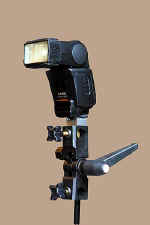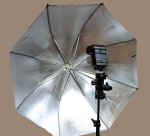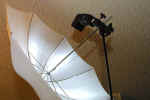The Beginner's Guide to Portrait Photography
I've gotten a lot of requests to document how the portrait images
were taken (see Friends and Family).
Now, I don't pretend to be an expert at studio photography -- far
from it. Most of what I know I learned through
experimentation. Also, if you want a studio perspective I'd
recommend visiting the excellent lighting site, www.lightingmagic.com.
However, you can do a lot of great portraits without a huge
investment in either equipment or knowledge. Here's the basics
of what I do (written from the perspective of using the Canon D30
and it's associated equipment -- you can do the same with film
and/or other digital cameras, by substituting the appropriate flash
units):
Equipment to make the process dead solid simple
is one of the keys. I use two Canon flash units, one 550 EX
and one 420 EX. You can use two of the same units, either the
420 (to save money) or two 550's if you've got the bucks. You
also get an E2 to control both of the flashes. This unit stays
on the camera and is triggered by the shutter, firing the other
flashes. (Note: you can also use a 550EX for a trigger but
since you will have to turn it off it's kind of a waste of
money). This way you have the camera doing ETTL and taking all
(or most) of the guesswork out of exposure (even though you have a
digital camera and can adjust things as you shoot, it's nice to have
an easy starting point). This will give you wireless control
of all your flash units -- if you're using a camera other than a
Canon EOS system you'll probably have to use wired flashes and/or
use slave triggers.
You must get your flash off camera. The biggest
mistake beginners make is thinking they can take nice flash pictures
with either the built-in flash or an external flash mounted on the
camera. Wrong! Your images will look like mug shots and
the shadows will be all wrong. You'll be amazed how wonderful
your images start looking when you move that flash off the camera.

To get the flash off
camera, you'll need some stands for the flash. Smith-Victor
has been making lighting stands for decades, and they still sell the
ones I use, the venerable S3 (around $30) . You'll also need
some hot shoe adapter to fit onto the light stand (and to hold the
umbrellas): Photoflex has a really nice Shoe mount Multi-clamp that
goes for $17 or so.
Umbrellas -- they're not just for rain. These are the devices that soften the light to give that wonderful
Northern light sort of look. There are lots of models out
there but I like the Photoflex ones. I have four of them: the
45" white satin ($16), the 45" convertible ($30), the
30" white satin ($17) and the 30" convertible ($24).
(I just don't have the studio space for the 60" models).
devices that soften the light to give that wonderful
Northern light sort of look. There are lots of models out
there but I like the Photoflex ones. I have four of them: the
45" white satin ($16), the 45" convertible ($30), the
30" white satin ($17) and the 30" convertible ($24).
(I just don't have the studio space for the 60" models).

You place your key light (your main light) off to one side of the
other. The key can be either shot through the umbrella (for a
really diffused look), bounced off the umbrella (less diffused) or
without an umbrella (very harsh for dramatic portraits).
You put your fill light directly behind your camera, above
you. Normally the fill is just bounced off the umbrella.
For a background I use black material placed about four to five
feet behind. It isn't critical as to color, since it shouldn't
receive much light (in our case all the portraits were shot in our
TV room and the black material was just draped over our big screen
TV). Doing high key portraits (with a white background) will
require either another background flash or to work very close to the
background so your key light will fall there as well (I have a third
420EX for this purpose).
Your model puts her face towards the key light but turns her eyes
back to the camera. Turn the D30 on to manual. Adjust
your flash EV to around +1 to +1 1/2. Now shoot. Adjust
your fill light (using the E2 for slave/master ratio) as
desired. You can even shoot without fill (some of the
portraits on this site were done without fill). Adjust your
flash EV if the exposure is too hot or too dark (but it should be
nearly right on).
That's all there is to it (but for full details, see
Portrait Lighting). The lighting stands and
umbrellas will cost you less than $150. Your biggest expense
will be the flash units and the E2. If you already have one
flash unit you can pick up a 420 and E2 for around $400. It's
all wireless and automatic exposure so there's no easier way to go.
